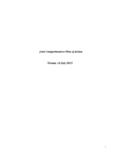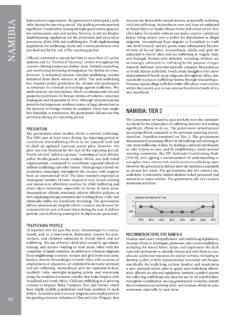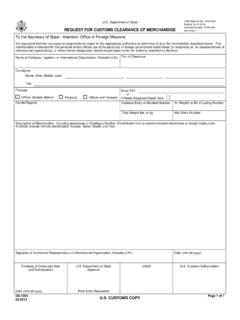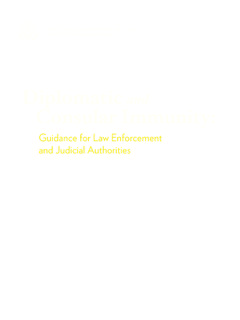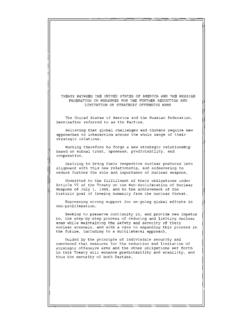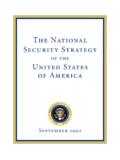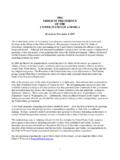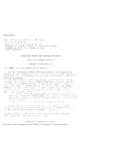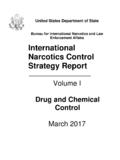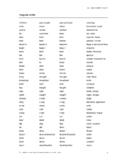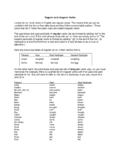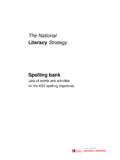Transcription of Country Reports on Terrorism 2016 - State
1 Country Reports on Terrorism 2016. July 2017. _____. United states Department of State Publication Bureau of Counterterrorism Released July 2017. Country Reports on Terrorism 2016 is submitted in compliance with Title 22 of the United states Code, Section 2656f (the Act ), which requires the Department of State to provide to Congress a full and complete annual report on Terrorism for those countries and groups meeting the criteria of the Act. Country Reports ON Terrorism 2016. Table of Contents Chapter 1. Strategic Assessment Chapter 2. Country Reports Africa Overview Trans-Sahara Counterterrorism Partnership Partnership for Regional East Africa Counterterrorism Burkina Faso Burundi Cameroon Chad Djibouti Eritrea Ethiopia Kenya Mali Mauritania Niger Nigeria Senegal Somalia South Africa Tanzania Uganda East Asia and the Pacific Overview Australia China (Hong Kong and Macau). Indonesia Democratic People's Republic of Korea Malaysia Philippines Singapore Thailand Europe Overview Albania Austria Azerbaijan Belgium Bosnia and Herzegovina Bulgaria Cyprus Denmark France Georgia Germany Greece Ireland Italy Kosovo Macedonia The Netherlands Norway Russia Serbia Spain Sweden Turkey United Kingdom Middle East and North Africa Overview Algeria Bahrain Egypt Iraq Israel, the West Bank, Gaza, and Jerusalem Jordan Kuwait Lebanon Libya Morocco Oman Qatar Saudi Arabia Tunisia United Arab Emirates Yemen South and Central Asia Overview Afghanistan Bangladesh India Kazakhstan Kyrgyz Republic Maldives Nepal Pakistan Sri Lanka Tajikistan Turkmenistan Uzbekistan Western Hemisphere Overview Argentina Brazil Canada Colombia Mexico Panama Paraguay Peru Trinidad and Tobago Venezuela Chapter 3.
2 State Sponsors of Terrorism Iran Sudan Syria Chapter 4. The Global Challenge of Chemical, Biological, Radiological, or Nuclear (CBRN) Terrorism Chapter 5. Terrorist Safe Havens (Update to 7120 report ). Terrorist Safe Havens Africa East Asia And Pacific Middle East South Asia Western Hemisphere Countering Terrorism on the Economic Front Multilateral Efforts to Counter Terrorism Long-Term Programs and Initiatives Designed to Counter Terrorist Safe Havens Countering Violent Extremism Civilian Counterterrorism Capacity Building Programs Regional Strategic Initiative Programs to Counter Foreign Terrorist Fighters Support for Pakistan Counterterrorism Coordination with Saudi Arabia Broadcasting Board of Governors Initiatives: Outreach to Foreign Muslim Audiences Visas for Participants in United states Programs Basic Education in Muslim Countries Economic Reform in Muslim Majority Countries Chapter 6. Terrorist Organizations Abdallah Azzam Brigades (AAB). Abu Nidal Organization (ANO).
3 Abu Sayyaf Group (ASG). Al-Aqsa Martyrs Brigade (AAMB). Ansar al-Dine (AAD). Ansar al-Islam (AAI). Ansar al-Shari'a in Benghazi (AAS-B). Ansar al-Shari'a in Darnah (AAS-D). Ansar al-Shari'a in Tunisia (AAS-T). Army of Islam (AOI). Asbat al-Ansar (AAA). Aum Shinrikyo (AUM). Basque Fatherland and Liberty (ETA). Boko Haram (BH). Communist Party of Philippines/New People's Army (CPP/NPA). Continuity Irish Republican Army (CIRA). Gama'a al-Islamiyya (IG). Hamas Haqqani Network (HQN). Harakat ul-Jihad-i-Islami (HUJI). Harakat ul-Jihad-i-Islami/Bangladesh (HUJI-B). Harakat ul-Mujahideen (HUM). Hizballah Indian Mujahedeen (IM). Islamic Jihad Union (IJU). Islamic Movement of Uzbekistan (IMU). Islamic State of Iraq and Syria (ISIS). Islamic State 's Khorasan Province ISIL-Libya ISIL Sinai Province (ISIL-SP). Jama'atu Ansarul Muslimina Fi Biladis-Sudan (Ansaru). Jaish-e-Mohammed (JeM). Jaysh Rijal Al-Tariq Al-Naqshabandi (JRTN). Jemaah Ansharut Tauhid (JAT). Jemaah Islamiya (JI).
4 Jundallah Kahane Chai Kata'ib Hizballah (KH). Kurdistan Workers' Party (PKK). Lashkar e-Tayyiba (LeT). Lashkar i Jhangvi (LJ). Liberation Tigers of Tamil Eelam (LTTE). Mujahidin Shura Council in the Environs of Jerusalem (MSC). Al-Mulathamun Battalion (AMB). National Liberation Army (ELN). Al-Nusrah Front (ANF). Palestine Islamic Jihad (PIJ). Palestine Liberation Front Abu Abbas Faction (PLF). Popular Front for the Liberation of Palestine (PFLP). Popular Front for the Liberation of Palestine-General Command (PFLP-GC). Al-Qa'ida (AQ). Al-Qa'ida in the Arabian Peninsula (AQAP). Al-Qa'ida in the Islamic Maghreb (AQIM). Al-Qa'ida in the Indian Subcontinent (AQIS). Real IRA (RIRA). Revolutionary Armed Forces of Colombia (FARC). Revolutionary People's Liberation Party/Front (DHKP/C). Revolutionary Struggle (RS). Al-Shabaab (AS). Shining Path (SL). Tehrik-e Taliban Pakistan (TTP). Chapter 7. Legislative Requirements and Key Terms ANNEXES: Annex of Statistical Information, prepared by National Consortium for the Study of Terrorism and Responses to Terrorism , A Department of Homeland Security Science and Technology Center of Excellence based at the University of Maryland Terrorism Deaths, Injuries and Kidnappings of Private Citizens Overseas in 2016, prepared by the Bureau of Consular Affairs, Department of State Chapter 1.
5 Strategic Assessment Although terrorist attacks and fatalities from Terrorism declined globally for the second year in a row in 2016, terrorist groups continued to exploit ungoverned territory and ongoing conflict to expand their reach, and to direct and inspire attacks around the world. The Islamic State of Iraq and Syria (ISIS) remained the most potent terrorist threat to global security, with eight recognized branches and numerous undeclared networks operating beyond the group's core concentration in Iraq and Syria. Al-Qa'ida (AQ) and its regional affiliates remained a threat to the homeland and our interests abroad despite counterterrorism pressure by partners and increased international efforts to counter violent Islamist ideology and messaging. Terrorist groups supported by Iran most prominently Hizballah continued to threaten allies and interests even in the face of intensification of financial sanctions and law enforcement. ISIS was driven out of roughly a quarter of the territory it held in Syria and Iraq at the beginning of the year through the combined efforts of Iraqi Security Forces and Syrian armed groups, enabled and supported by the 73 members of the Global Coalition to Defeat ISIS.
6 At the same time, diplomatic efforts contributed to strengthening a broad range of travel controls that helped choke off the flow of foreign terrorist fighters to ISIS-held territory in Iraq and Syria. Along with battlefield deaths, the reduction in the flow of recruits left ISIS at its lowest battlefield strength since at least 2014. In Libya, government forces and aligned armed groups, supported by air strikes, drove ISIS out of its main Libyan stronghold in Sirte. Many ISIS fighters in Darnah and Benghazi also were driven out by the end of 2016. ISIS attacks outside its territorial strongholds in Iraq, Syria, and Libya were an increasingly important part of its Terrorism campaign in 2016. Most of these attacks took place in countries where ISIS has a declared branch, such as Afghanistan, Egypt, Saudi Arabia, and Yemen. Elsewhere around the globe, returning foreign terrorist fighters and homegrown violent extremists carried out attacks directed, assisted, or inspired by ISIS.
7 The attacks in Brussels on March 22, carried out by the same operational cell that conducted the November 2015 Paris attacks, and attacks in Istanbul, are examples of this. Other operations outside of Iraq and Syria were conducted by individuals who were unable to travel to that region and instead conducted attacks in their home countries or regions. ISIS sought to exploit refugee and migrant flows to disguise the travel of its operatives, causing alarm but resulting in increased vigilance in many of the destination countries. ISIS continued to commit atrocities against groups in areas under its control, including Yezidis, Christians, Shia Muslims, Sunni Muslims, Kurds, and other groups. In 2015 and 2016, ISIS abducted, systematically raped, and abused thousands of women and children, some as young as eight years of age. Women and children were sold and enslaved, distributed to ISIS fighters as spoils of war, forced into marriage and domestic servitude, or subjected to physical and sexual abuse.
8 ISIS established markets where women and children were sold with price tags attached and has published a list of rules on how to treat female slaves once captured. (For further information, refer to the Trafficking in Persons report 2016, ). The recruitment of violent extremists through social media remained central to ISIS's terrorist campaign in 2016. The United states and its partners worked closely with social media companies and others to lawfully counter and curtail use of the internet for terrorist purposes. Due in part to these efforts, ISIS content on the internet declined 75 percent from August 2015 to August 2016, while ISIS-related traffic on Twitter declined 45 percent from mid-2014 to mid-2016. This coincided with a steep reduction in the monthly rate of official visual media releases by ISIS, from 761 in August 2015 to 194 in August 2016, according to a study published by the Combating Terrorism Center at West Moreover, ISIS had 19 active media outlets at the beginning of 2017, down from at least 40 in 2015, according to another study published by the Council on Foreign Even as ISIS attacks increased in 2016, the world experienced fewer terrorist attacks and fewer fatalities from Terrorism for the second year in a row, due largely to declines in South and Central Asia and the Lake Chad Basin region of Africa.
9 In the Lake Chad Basin, military gains by the Multinational Joint Task Force (MNJTF) and its member states against both Boko Haram and ISIS-West Africa, a Boko Haram off-shoot that emerged in 2016, helped drive down terrorist attacks and fatalities in Nigeria and elsewhere in the Lake Chad Basin region over much of the year. Al-Qa'ida and its regional affiliates exploited the absence of credible and effective State institutions in some states and regions to remain a significant worldwide threat despite sustained pressure by the United states and its partners. Despite leadership losses, al-Qa'ida in the Arabian Peninsula (AQAP) remained a significant threat to Yemen, the region, and the United states , as ongoing conflict in Yemen hindered efforts to counter the group. Al-Qa'ida's affiliate in Syria, al-Nusrah Front, continued to exploit ongoing armed conflict to maintain a territorial safe haven in select parts of northwestern Syria. Al-Shabaab, which pledged allegiance to al-Qa'ida in 2012, continued to conduct asymmetric attacks throughout Somalia and parts of Kenya despite weakened leadership and increasing defections.
10 In February, al-Shabaab claimed responsibility for a suicide bomb attack aboard a Daallo Airlines flight from Mogadishu that resulted in the death of the attacker, but failed to destroy the aircraft as intended. The attack demonstrated that civilian aviation targets remain a high priority for international terrorist groups despite the broad improvements in aviation security. Al-Qa'ida in the Islamic Maghreb (AQIM) and its affiliates in Mali shifted their operational emphasis from holding territory to perpetrating asymmetric attacks against government and civilian targets, including hotels in Burkina Faso and Cote d'Ivoire, as well as UN peacekeeping forces in northern Mali. Al-Qa'ida in the Indian Subcontinent (AQIS) continued to operate in South Asia, which the AQ-core has historically exploited for safe haven, and it claimed several attacks targeting religious minorities, police, secular bloggers, and publishers in Bangladesh. In Afghanistan, 1. Daniel Milton, Communication Breakdown: Unraveling the Islamic State 's Media Efforts, Combating Terrorism Center at West Point, October 2016, unraveling-the-islamic- states -media-effo rts.
